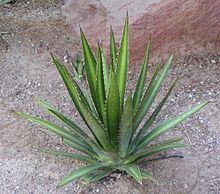Agave lechuguilla
| Agave lechuguilla | |
|---|---|

| |
| Scientific classification | |
| Kingdom: | Plantae |
| Clade: | Tracheophytes |
| Clade: | Angiosperms |
| Clade: | Monocots |
| Order: | Asparagales |
| Family: | Asparagaceae |
| Subfamily: | Agavoideae |
| Genus: | Agave |
| Species: | A. lechuguilla
|
| Binomial name | |
| Agave lechuguilla | |
| Synonyms[3] | |
| |
Agave lechuguilla (common name in Chihuahua: lechuguilla, meaning "small lettuce") is an Agave species found only in the Chihuahuan Desert. The plant flowers once in its life and then dies.
Description[edit]
The plant reproduces most often through underground offshoots, creating large colonies.[4] It also can flower at any time after the plant has reached three to 21 years of age, producing a leafless stalk that can reach 3.7 metres (12 feet) in height.[4] The flower clusters are located at the top and are funnel-shaped in purples, reds, and yellows.[4] The plant dies after flowering in May–July.[4][5] The leaves are long, tough, and rigid, with very sharp, hard points that can easily penetrate clothing and even leather, giving the colloquial name "shin-daggers".
Taxonomy[edit]
Charles Wright first collected the plant in 1849 and it was described by John Torrey in 1859.[4]
Distribution and habitat[edit]
It is an indicator species in the Chihuahuan Desert, the only place it is found.[6] It typically grows on calcareous soils.[7]
Ecology[edit]
The plant makes up a large part of the diet of the collared peccary (javelina) in some areas.[8] Additionally, the flowers are a source of nutrients for insects, bats, and some birds. The plant is toxic to cattle and sheep, however.[9]
Uses[edit]
The water stored in the flowering stalks of this plant, rich in salts and minerals, is sold in Mexico as a sport drink. Native Mexicans have used fibers from the leaves (commonly called ixtle).[5] Roots of the plants were used as soap by Native Americans.[4]
References[edit]
- ^ Hernández Sandoval, L.; Zamudio, S.; González-Elizondo, M.; Hernández-Martínez, M.; Matías-Palafox, M.; Sánchez, E. (2019). "Agave lechuguilla". IUCN Red List of Threatened Species. 2019: e.T44393414A125198188. doi:10.2305/IUCN.UK.2019-3.RLTS.T44393414A125198188.en. Retrieved 11 November 2021.
- ^ "Agave lechuguilla". Germplasm Resources Information Network. Agricultural Research Service, United States Department of Agriculture. Retrieved 2011-05-02.
- ^ Kew World Checklist
- ^ a b c d e f Morey, Roy (2008). Little Big Bend : Common, Uncommon, and Rare Plants of Big Bend National Park. Lubbock: Texas Tech University Press. p. 37. ISBN 9780896726130. OCLC 80359503.
- ^ a b Spellenberg, Richard (2001) [1979]. National Audubon Society Field Guide to North American Wildflowers: Western Region (rev ed.). Knopf. p. 325. ISBN 978-0-375-40233-3.
- ^ West, Steve (2000). Northern Chihuahuan Desert Wildflowers. Globe Pequot. p. 44. ISBN 978-1-56044-980-5.
- ^ Turner, Matt (2009). Remarkable Plants of Texas: Uncommon Accounts of Our Common Natives. Austin: University of Texas Press. pp. 109–113. ISBN 978-0-292-71851-7.
- ^ Corn, J. L. and R. J. Warren. (1985). Seasonal food habits of the collared peccary in South Texas. Journal of Mammalogy. 66:1 155-59.
- ^ Lechuguilla. Archived April 3, 2012, at the Wayback Machine Toxic plants of Texas. Texas A&M.
Further reading[edit]
- Flora of North America Editorial Committee (ed.). "Agave lechuguilla". Flora of North America North of Mexico (FNA). New York and Oxford: Oxford University Press – via eFloras.org, Missouri Botanical Garden, St. Louis, MO & Harvard University Herbaria, Cambridge, MA.
External links[edit]
 Data related to Agave lechuguilla at Wikispecies
Data related to Agave lechuguilla at Wikispecies Media related to Agave lechuguilla at Wikimedia Commons
Media related to Agave lechuguilla at Wikimedia Commons- USDA Plants Profile for Agave lechuguilla (lechuguilla)
- University of Michigan - Dearborn: Native American Ethnobotany: Agave lecheguilla (Maguey lechuguilla)

